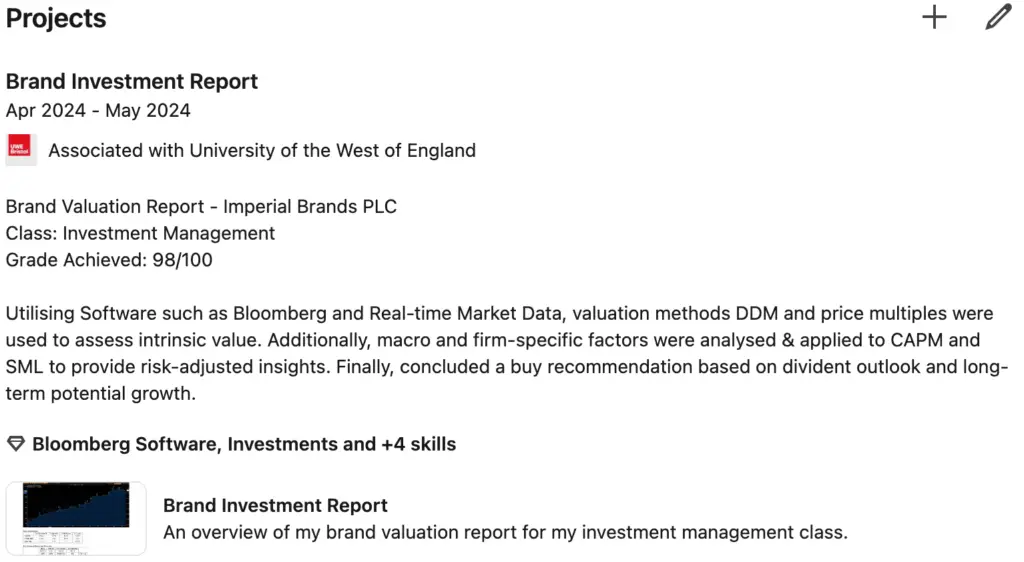Picture this: you’re in university, juggling assignments and exams, a part-time job, running on 2 hours of sleep, and somebody has just told you to start taking LinkedIn more seriously. Immediately, you might be thinking you have no idea where to start, what it’s about, or what to even include. This is where I come in and walk you through the absolute basics and essentials, and what I wish I knew when I first started university.

Why is LinkedIn so important?
Firstly, what exactly is LinkedIn? It’s a form of social media primarily used by students, graduates, and employers. On this site, it is recommended to post your achievements, connect and network with other individuals, and search for potential internships, graduate schemes, and further opportunities. For those undertaking a creative degree, LinkedIn is especially important for forming a digital portfolio and reaching potential recruiters! Aside from education and experience, however, it is also a brilliant way to professionally share your hobbies and personality to show what sets you apart from other individuals.
Creating your LinkedIn profile
As with any social media, you will have the option to select a profile picture, and you might be thinking you don’t have any professional headshots… For this, I would recommend asking a family member or friend to help take some photos of you against a plain background or using photos from formal events you might have previously attended.
When it comes to your LinkedIn banner, students in creative sectors have a great opportunity to showcase their work visually, either through a photo carousel, design, or even highlighting a past project. For everyone else, I would recommend keeping things clean and simple: include your name, a way to contact you (preferably set up a ‘work’ email), and a clear headline that reflects how you want to introduce yourself professionally.
Writing your ‘About’ section
In simple terms, a section is a brief description of yourself professionally, advertising to prospective recruiters who stumble across your page. In this, you should try to include the subject in which you are currently studying, what your main interests are, and any future short-term goals.
Education
You might think that starting out at university, you won’t have a lot of ‘professional’ experience, thus you should highlight your academic achievements the most. However! Contrary to popular belief, although education plays a large role, employers will largely look out for your experiences more, though this is not to say that you can’t pick up lots of experience throughout your time at university. For instance, you could consider becoming a student representative, a tutor, joining a society’s committee, and even more! All of these are highly valuable commitments that you could pursue and include in the education or experience section.
The majority of this section will include all major academic achievements that you have obtained, or are expected to receive, such as GCSEs, A-levels, BTECS, and individual university modules. Most employers will pay attention to your Maths and English GCSE grades, A-level results, and your final class for your university degree. You may also choose to highlight any specific modules that you did particularly well within or are highly relevant to a career that you are pursuing and would like to make obvious to future recruiters.
Experience
In this section, you should include any types of work that you have undertaken, such as part-time, volunteering, internships, spring weeks, and any other relevant experiences. Underneath each title, provide a brief description of the main responsibilities you handled that are relevant to the career you are choosing to pursue. Additionally, ensure you are quantifying the results of your responsibilities, where possible, with a percentage or number to solidify your contributions and action words to seem less passive. My personal preference is to include 4 – 5 solid bullet points of your responsibilities that provide a scope and overview of your time in this position.
LinkedIn also allows you to enter skills in this section, which is highly recommended to fill in as you start learning what skills seem desirable to recruiters that you also possess. These keywords are also commonly found throughout job descriptions, and can make tailoring your CV and cover letter much easier. Be sure to also check out this article on CVs.
Projects
This section is extremely underrated in my opinion, as it allows you to highlight any specific assignments or personal projects that you have undertaken. It’s a great area to point out any software that you have used throughout the project and describe key skills that are commonly used throughout the industry as well. Finally, I would also recommend attaching a file of the project as this allows others to read about your work and showcase your skills through a real-time application.

Awards and certifications
If you are lucky enough to have already got some extracurricular activities, additional certificates, or completed courses outside your main field of study under your belt, this is the perfect place to highlight them. Employers greatly value candidates who have taken the initiative to grow actively, and this is a great addition to your CV to stand out from the crowd. There’s no shortage of free online courses that are widely recognised certifications that can also boost your profile, especially if they relate to the industry you are looking to enter. Some of my go-to platforms for these include The Open University, Bright Network, and LinkedIn Learning.
Some universities have a Dean’s List, where, at the end of the academic year, students within a certain percentile are academically recognised and placed on a publicised list, congratulating them on their achievements. Most universities consider this to be a student’s overall grade for the year, which must be above 70% and include a first-class. This is a highly prestigious award for students, and it is worth mentioning in this section if you have received it.
Networking
Now that you have built up a LinkedIn profile, your main priority should be to cultivate connections (think of this as professional friend requests). To start networking, build up connections with people you are closest to, such as classmates, friends, or peers. You could also branch out to connect with your lecturers, tutors, or other academic staff who are key counterparts to accessing University Alumni, as well as forming recommendations. Academic staff are also great to connect with, as their previous work experiences may include a firm that you are currently trying to apply to. In this case, you may choose to reach out to individuals in your network for advice about the company, information on the recruitment process, or ask them to recommend you.
More importantly! If you are trying to apply for organisations that have a LinkedIn page, it is highly recommended to follow their accounts, subscribe to the newsletters, and stay up to date on what’s happening. Not only will this provide you with further insight into how the companies operate, but you can also come across as a well-researched individual who highly engages with the company’s social media throughout interviews.

Your feed and what to post
By now, your feed should be filtered to things that people in your network have posted or reposted, or updates from the accounts you follow. So where does that leave you? Well, throughout your first year, you might have an assignment that you worked extremely hard on and received a grade that you are proud of. This is the perfect opportunity to discuss what happened throughout the project, what skills you developed, and why you are proud of the grade you received. Finally, add a few hashtags, attach the project file, and hit post!
Other things you might choose to post about could include any end-of-year academic reflections, experiences on part-time jobs, volunteering, internships, and spring weeks, and more! Think of LinkedIn as a professional place to showcase your abilities and personality, and the rest is history.

Topic expertise: Student Cities, Cost of Living, Nightlife, Wellbeing, Accommodation
FAQs: How to actually start building your LinkedIn profile – a guide for students
Use a benefit-led headline that blends what you study, the role you want and a core skill: “Psychology student seeking marketing internship | Data storytelling & Canva | Society VP.” Avoid just “Student at X University”; keywords help recruiters find you. In your About, write 4–6 short lines covering your interests, proof (projects, grades, competitions), tools you can use, and what you’re looking for next.
In Experience, include part-time jobs, volunteering, society roles, course projects and hackathons. Treat each like a mini role: 2–4 bullet points starting with strong verbs and outcomes (numbers, time saved, engagement, revenue, grades). If it’s a class project, name the client or problem, your contribution, tools used (Excel, Python, Canva, Premiere Pro), and the result (“A/B test increased click-through by 12%”).
Start with people who know your work: classmates, lecturers, internship managers, alumni from your course, and society committees. Send short, personalised notes: “Hi Ayesha, I’m a 2nd-year Econ student exploring policy research—loved your thread on cost of living dashboards. Would love to connect.” Use the Alumni tool on your university page to filter by role, city and industry, then request 10–15 high-quality connections per week.
Post short, useful updates weekly: a 3-point lesson from a lecture, a project thread with one visual, or a mini case study from your part-time job (e.g., how you improved a process). Showcase work-in-progress and what you learned—not just perfect outcomes. Use 3–5 specific hashtags (e.g., #DigitalMarketing, #StudentNurse) and tag organisations or tools you used when appropriate.
Switch on “Open to Work” for internships and set job titles, locations and hybrid/remote preferences. Customise your public profile URL (linkedin.com/in/YourName) and add it to your CV, email signature and portfolio. Fill the Skills section with 15–25 targeted keywords taken directly from job descriptions (tools + soft skills), then reorder the top three to match your goals.
Authors
-
Hi, I'm Tori! I'm a recent graduate from UWE Bristol, where I previously studied Business & Management for 3 years. I'm currently seeking employment in the realm of finance, but whilst that is in the works, I'm now sharing all my knowledge I gained through university and passing it on to all of you reading this. Thanks for checking my articles out! I hope that my tips and tricks help you prepare or get through university slightly easier.
View all posts
-
Aminah is a dedicated content expert and writer at Unifresher, bringing a unique blend of creativity and precision to her work. Her passion for crafting engaging content is complemented by a love for travelling, cooking, and exploring languages. With years spent living in cultural hubs like Barcelona, Sicily, and Rome, Aminah has gained a wealth of experiences that enrich her perspective. Now based back in her hometown of Manchester, she continues to immerse herself in the city's vibrant atmosphere. An enthusiastic Manchester United supporter, Aminah also enjoys delving into psychology and true crime in her spare time.
View all posts


